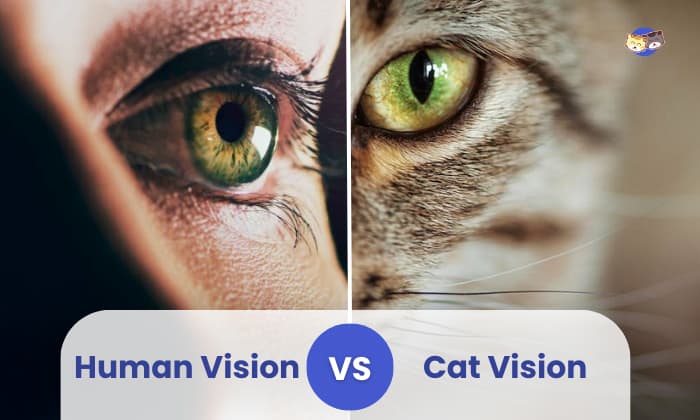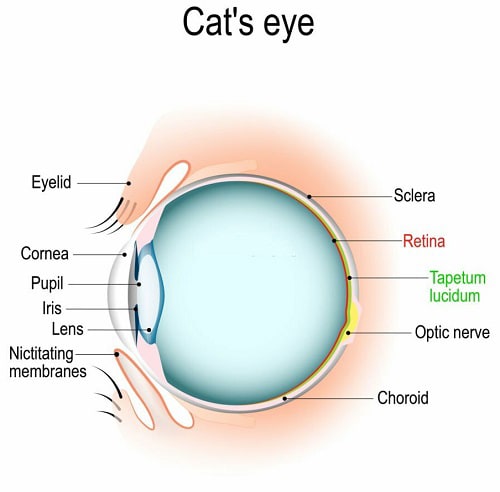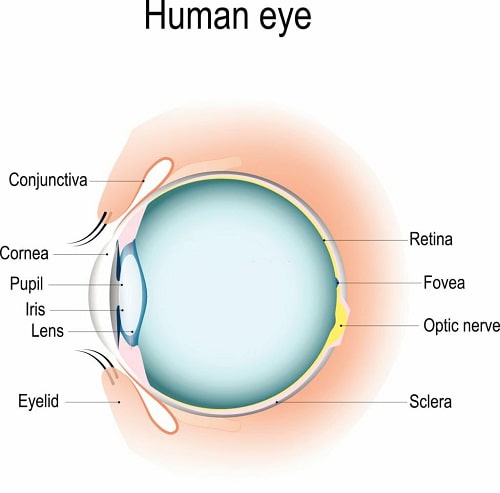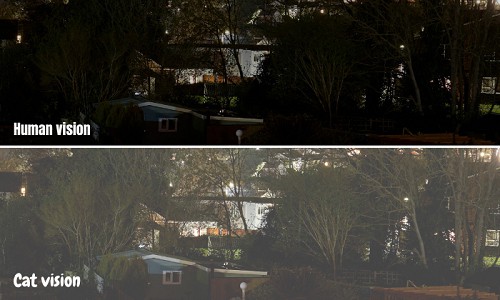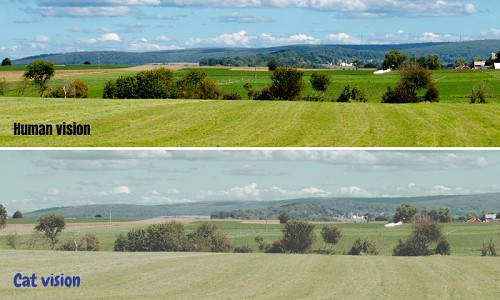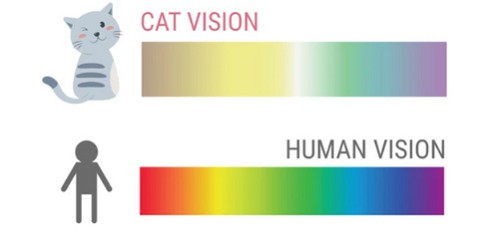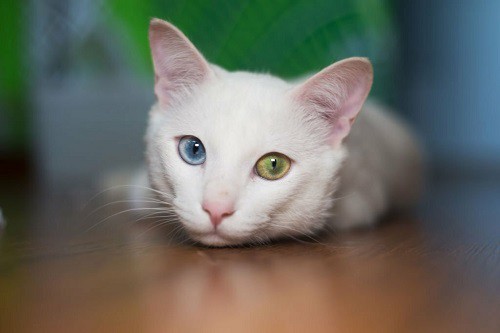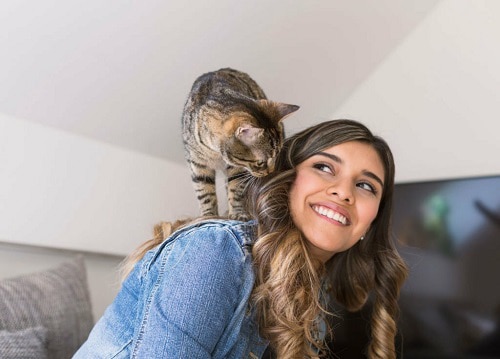Human and animal eyes have the same function: To see.
Yet, when you walk in dark streets and stumble upon cats with glowing eyes staring back at you, you will see how our eyes have different features from theirs. Why is that?
Simply put, each type of species relies on eyes to do different things. So, rather than debating who can see better, let’s explore the distinct features of human and feline eyes and their differences.
This table shows a comparison between human vision vs cat vision in a nutshell:
| Human Eyes | Cat Eyes | |
| Visual field | 180 degrees | 200 degrees |
| Color vision | Sees blue, green, and red | Sees blue and green while red and pink become greenish in their eyes |
| Saturation | Vivid | Desaturated |
| Visual acuity | 20/20 vision gives humans a clear view even when standing 100 feet away from the object | 20/100 to 20/200 vision means that cats need to stand at least 20 feet from an object to see with clarity. |
| Night vision | Needs more light to see | Requires only one-sixth of the light that humans need to see |
Table of Contents
Overview
1. Cat Eye Anatomy
When you look at a cat’s eye, you are looking at its cornea. You may not see it because it is transparent, but this dome-shaped layer is responsible for directing light to the retina. Moreover, it also serves as a shield against dust, bacteria, and other foreign objects.
Another visible portion is the iris and pupil. As with the human eye, the iris is round and colored. Some cat breeds have yellow or green irises while others have blue. Right in the center of the iris is the pupil that controls the amount of light by widening to add more light or shrinking to lessen it.
The lens is the part that sits behind the iris. Thanks to ciliary muscles, the lens can switch the focus to objects near and far by turning the lens thicker or thinner.
On the outermost layer is the sclera, which is the white portion of the eyes. Located underneath the eyelid is the conjunctiva, which covers the sclera.
2. Cat Eye vs Human Eye Anatomy
In the diagrams of human and feline eye anatomy above, you will notice that they share similarities. Both have the retina, a type of tissue where the two types of photoreceptors —rods and cones—are located.
Photoreceptors convert light into signals that travel to the brain via optic nerves, allowing us and our four-legged friends to see a picture of what’s in front of us. Similar to cats, humans also have the cornea, iris, pupil, and lens.
The major difference between us and them is that cats have more rods and fewer cones than humans.
On the flip side, humans have more cones and fewer rods. By knowing this, you can begin to understand how animal vision is better than human vision at night but is less perceptive of colors.
How Cats and Humans See the World Differently
1. Day and night vision
A cat’s glowing eyes contain a layer of tissue known as tapetum lucidum. Due to its glow, it can reflect light, which allows animals to maintain good vision at night.
Moreover, cats are crepuscular by nature. Animals that are nocturnal or crepuscular tend to have big eyes in relation to the size of their heads.
In conjunction with the higher number of rods, they can receive more light even in dim lighting conditions, giving them a superior ability to sense movement.
Aside from that, a cat’s pupils are like slits that stand vertically. The shape can change in size a lot faster than the round pupils of humans to filter light more effectively.
Humans, on the other hand, have better daytime vision than cats. When the sun is up or the lights are on, we can detect the slowest movement from far away that cats may not even notice.
In contrast, felines are better at detecting fast movements, which is beneficial for hunting.
2. Visual field, distance, and acuity
According to the American Optometric Association, visual acuity refers to clarity of vision. As most of you already know, 20/20 vision indicates that you can see objects clearly when standing 20 feet away.
A cat’s vision is anywhere between 20/100 to 20/200. This means that they have to stand 20 feet away to see an object that a person with perfect vision can see clearly at 100 or 200 feet.
Visual field, on the other hand, is defined as the total space wherein objects can be seen when looking in one direction.
As stated in the table above, felines have a visual field of 200 degrees. This comes in handy when they are looking for their prey. By contrast, humans have a narrower visual field of 180 degrees.
3. Colors
Except for those with color blindness, the human eyes can see most of the color spectrum vividly.
As for the cat’s eyesight, objects appear mostly in blue and green. Purple shades become bluish whereas pink and red look more like green. Apart from that, the colors appear desaturated.
Bonus: What do cats see when they look at humans?
You probably have seen how good your feline baby is at detecting objects and movement at night in cat vision simulation videos. Although how they see humans remains a mystery, some experts suggest that we may be viewed as feline giants or a family member.
However, if you have been nurturing your pet or neighborhood cat, you may also be perceived as a source of food and affection. In a 2013 study, researchers found that cats can tell their fur parents apart from a crowd of strangers.
Conclusion
To sum up this article on human vision vs cat vision, we learned that cats have a wider visual field and the ability to see in dim lighting thanks to their tapetum lucidum and high concentration of rods in their retinas.
But that does not mean that their eyesight is better than humans. Despite having a slightly narrower visual field, we can see the world around us in vivid colors. Our eyes are also adept at seeing objects at greater distances with clarity.

I am Amy Sawy, a Doctor of Veterinary Medicine (DVM) graduate from the University of Kansas. y husband, Dr. Plummer, and I own a veterinary clinic in Phillipsburg, Kansas. In addition to my professional background, I am a devoted pet owner myself, with a household that includes dogs, rodents, and most notably, cats – a total of five felines in my home.
In 2020, I joined an organization as a professional writer, leveraging my experience and collaborating with my team to deliver the most valuable information for your cat’s care.


